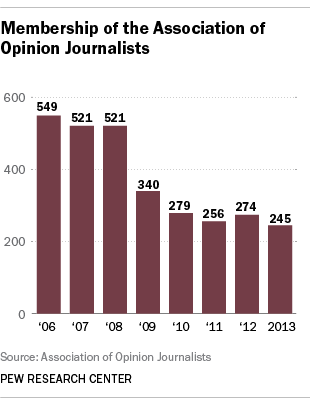Much has been written about newspapers cutting staffs, news pages and bureaus in response to financial pressures in recent years. But a growing number of dailies also have reduced the amount of newsprint they devote to editorials and commentary, a departure from tradition that has gone largely unnoticed outside the affected communities.
The latest and perhaps most prominent example is the Philadelphia Inquirer, which announced in September that it was cutting in half—from two to one—the number of pages allotted to editorials and opinions on weekdays, triggering protests. There is no formal tally of reductions in editorials and commentary, but Pew Research Center interviews with editors across the country have confirmed a gradual shift both in the amount of space given over to opinion and in the missions of editorial and op-ed pages. Some papers have tried to compensate by running more editorials and columns online and launching more opinion-driven blogs. Some have shifted away from one of the historic missions of newspapers—influencing public opinion—and instead seek to foment community conversations online.

“The trend over the last dozen years or so is that editorial departments have lost space and personnel,” said Bob Davis, associate publisher/editor of The Anniston (Ala.) Star, which has cut one opinion page per week. “People are looking at themselves less as being an editorial voice and more as being a stimulator of conversation.”
One telling sign of the cutbacks is membership in the Association of Opinion Journalists, the organization that represents editorial writers and columnists. In 2006, before most newspaper downsizing took place, the AOJ had 549 members. Since then, membership has plunged 55%, to 245 this year.
Some examples of this changing landscape:
- The Seattle Times a few years ago dropped one of its two opinion pages on Tuesdays through Fridays to save money. It also stopped using some syndicated columnists, figuring people could read them on other Web sites, said Editorial Page Editor Kate Riley. Now, she said, the editorial page focuses on local and regional issues while commentary on the paper’s web site has been beefed up. “This is not a company that is abandoning its opinion pages,” Riley said. “The idea that fewer print pages is a measure of such commitment is Twentieth-Century thinking.”
- The Kansas City Star eliminated one of its three weekday opinion pages in late 2008 and one of three Sunday pages in 2011. Miriam Pepper, vice president/editorial page, said that while some readers turn to the paper’s Web site to read commentary, that is not for everyone. “It does really worry me that some papers are shrinking op-ed space,” Pepper said. “We’re the last place where communities can really have conversations that reach a really diverse audience.”
- The Scripps Treasure Coast Newspapers in Florida (comprising the Stuart News, the Indian River Press Journal and the St. Lucie News-Tribune) actually added two opinion pages on Sundays, but reduced the number of editorials they produce. As if to illustrate a shift in focus, Scripps changed Larry Reisman’s title from editorial page editor to audience engagement and opinion editor. “If we don’t have anything that we have to say,” Reisman said, “then we don’t say it.”
- The South Florida Sun-Sentinel eliminated its op-ed page a few years ago, but reinstated a half page in response to an outcry from readers. Earlier this year, the paper added more space for opinion. But, Editorial Page Editor Rosemary Goudreau said, in the past decade, the number of editorial writers has dropped from 11 to five.
- Many newspapers have cut editorial cartoonists and syndicated columnists in print and online. Jack Newcombe, president of Creators Syndicate, which represents 200 writers and artists, said he’s had to look to different types of Web sites to run his clients’ opinion columns because “it’s absolutely harder” to sell to newspapers these days.
- The reduction in space at the Philadelphia Inquirer has been particularly contentious, with Editorial Page Editor Harold Jackson urging op-ed contributors to protest to the paper’s owners, a group of local investors. Publisher Bob Hall said that although the Inquirer has endured repeated rounds of financially induced cutbacks in recent years, the decision to eliminate the op-ed page “was not done at all for cost-cutting purposes.” Hall said that in focus groups, people said the paper had “too many editorials, too much bias” and that some, but not all, of the space will be made up with an extra page on Sundays. Still, Hall acknowledged that many readers have complained about the cuts. On Monday, Hall fired Inquirer Editor William K. Marimow, citing “philosophical differences” over the newspaper’s direction.